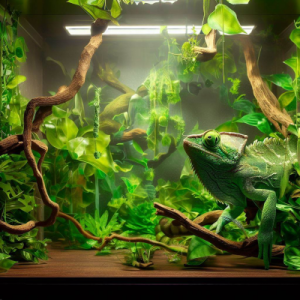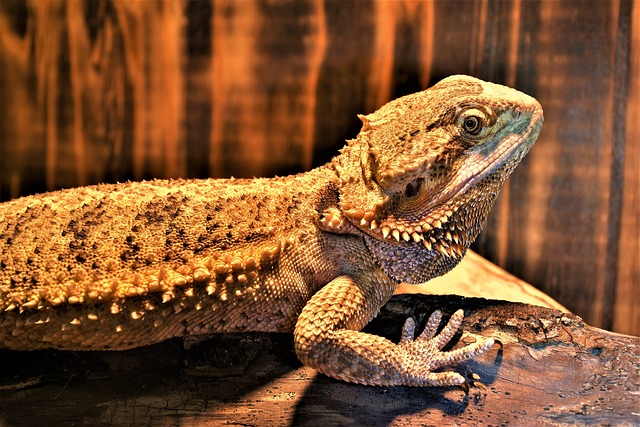Are you a chameleon owner looking for a comprehensive guide to ensure the health and well-being of your reptile companion? Look no further than ‘Ultimate Chameleon Care: A Comprehensive Guide for Healthy Chameleons’.
This guide covers all aspects of chameleon care, from preparation and diet to breeding and medical conditions. It provides valuable tips on feeding, handling, and bonding with chameleons, as well as identifying and treating medical conditions.
With this guide, you’ll have all the information you need to create the perfect habitat and ensure the best care for your chameleon friend.
Key Takeaways
 Proper care and preparation are essential before getting a chameleon
Proper care and preparation are essential before getting a chameleon- Understanding the signs of a healthy chameleon and the necessary conditions for their well-being
- The importance of a balanced diet and creating an ideal feeding environment for chameleons
- Tips for proper handling, identifying and treating medical conditions, and creating a safe habitat for chameleons
Chameleon Care and Preparation
Before bringing home a chameleon, make sure you consider the necessary conditions for their health and have all the supplies they need for a suitable habitat. Proper chameleon enclosure setup is crucial to their well-being. Chameleons require a spacious enclosure with plenty of branches and foliage for climbing and hiding.
The enclosure should also have proper lighting, including UVB bulbs for their calcium metabolism. Maintaining the correct temperature and humidity levels is essential for their overall health.
Additionally, it is important to learn proper chameleon handling techniques to avoid stressing or injuring your pet. Chameleons are delicate creatures, so it is best to handle them infrequently and with gentle, slow movements. Always support their body and allow them to move at their own pace.
Diet and Feeding
To ensure your chameleon stays healthy, it’s important to provide a balanced and nutritious diet. Creating a balanced chameleon diet involves offering a variety of insects, such as crickets, mealworms, and waxworms, as well as occasional fruits and vegetables. These insects should be gut-loaded with nutritious foods to ensure your chameleon receives the proper nutrients.
Additionally, it’s crucial to provide a suitable watering and hydration system for your chameleon. Chameleons obtain water by licking droplets off leaves, so misting their enclosure several times a day is essential. You can also provide a dripper system or a shallow dish of water for them to drink from. Remember, proper hydration is vital for their overall health and well-being.
Care Tips
Maintaining a suitable habitat for your chameleon is crucial to their well-being and overall health. When it comes to chameleon care, there are important handling techniques that you need to know.
Chameleons are delicate creatures, so it’s essential to handle them with care. Always support their body and avoid excessive handling, as it can cause stress and injury.
Additionally, it’s crucial to prevent common health issues that chameleons may face. Regularly monitor their behavior and appearance for any signs of illness. Ensure they have proper UVB lighting, appropriate temperatures, and a clean environment to prevent respiratory infections and other diseases.
Providing a balanced diet and maintaining proper hydration are also essential for their overall health.
Breeding
When breeding chameleons, it’s important to create the right conditions for successful reproduction. Breeding techniques for these fascinating creatures can be challenging, but with proper knowledge and preparation, you can increase your chances of success.
One technique is to provide a suitable breeding enclosure with ample space, appropriate lighting, and a well-maintained temperature and humidity level. It’s crucial to ensure that the male and female chameleons are in optimal health before attempting breeding.
Introduce them gradually, allowing them to become familiar with each other’s presence. However, it’s essential to closely monitor their behavior and separate them if any aggression occurs.
Breeding challenges may arise, such as infertility or the female rejecting the male’s advances. In such cases, consulting with an experienced reptile breeder or veterinarian can provide valuable insights and guidance.
With patience and perseverance, breeding chameleons can be a rewarding and fulfilling experience.
Popularity and Care Effort
You can easily find specialized veterinarians who are trained to care for reptiles like chameleons. These veterinarians have the knowledge and expertise to provide the best possible care for your pet chameleon. They understand the unique needs and requirements of these fascinating creatures and can offer guidance on proper nutrition, habitat setup, and health maintenance.
In addition to specialized veterinarians, there is also a growing market for reptile accessories, including chameleon-specific products. These accessories are designed to enhance the chameleon’s environment and provide them with the necessary tools for a happy and healthy life. From UVB lighting to humidity control devices, these accessories can help create the ideal conditions for your chameleon.
Necessary Supplies
To ensure the well-being of your pet chameleon, it’s important to have the necessary supplies ready and accessible.
Creating a chameleon habitat involves providing a spacious enclosure with proper ventilation and temperature control.
You’ll need to select the right lighting for chameleons, which includes both UVB and heat lamps. UVB lighting is crucial for chameleons as it helps them synthesize vitamin D3, essential for calcium absorption and overall health.
Heat lamps are necessary to create a temperature gradient within the enclosure, allowing your chameleon to regulate its body temperature.
It’s also important to include foliage and branches for climbing and hiding, as well as a water source for drinking and misting.
Medical Conditions and Treatment
Identifying and treating medical conditions is crucial for maintaining the health of your pet chameleon. As a responsible chameleon owner, it is important to be aware of the common illnesses that can affect your reptile companion. Here are some key points to keep in mind:
-
Regularly monitor your chameleon for any signs of illness, such as changes in appetite, lethargy, or unusual behavior.
-
If you suspect that your chameleon is sick, seek veterinary advice promptly. A specialized reptile veterinarian will be able to properly diagnose and treat your chameleon.
-
Follow the veterinarian’s recommendations for proper medication and treatment. This may include administering oral medication, using topical ointments, or providing supportive care.
-
Ensure that your chameleon’s enclosure offers the right environmental conditions for recovery, such as appropriate temperature and humidity levels.
-
Prevention is key. Maintain good hygiene practices, provide a balanced diet, and keep stress levels low to minimize the risk of illness.
Safe Habitat
Creating a safe habitat is essential for the well-being of your pet chameleon. When designing a chameleon habitat, it is important to consider their specific needs.
Chameleons require a spacious enclosure with plenty of climbing branches and foliage to mimic their natural environment. The temperature regulation is crucial for their health, so make sure to provide a basking spot with a heat lamp that maintains the proper temperature range of 80-85°F during the day and 65-75°F at night.
Additionally, a UVB light is necessary to provide the chameleon with essential vitamin D3 for calcium absorption. It is important to monitor the humidity levels as well, as chameleons need a humidity range of 50-70%.
Frequently Asked Questions
How long do chameleons typically live in captivity?
Chameleons typically live for about 5 to 10 years in captivity, although some species can live up to 15 years or more with proper care.
The lifespan of a chameleon can be influenced by various factors, such as species, genetics, diet, habitat conditions, and overall health.
Providing a suitable environment, a balanced diet, regular veterinary care, and minimizing stress can help maximize the lifespan of your chameleon.
Are there any specific regulations or permits required to own a chameleon as a pet?
When it comes to owning a chameleon as a pet, there are no specific regulations or permit requirements. That’s right, you don’t need to jump through any hoops or fill out any paperwork! Chameleons make wonderful pets and there are no legal barriers standing in your way.
However, it’s always a good idea to check with your local authorities to ensure there are no specific rules or restrictions in your area.
Happy chameleon ownership!
Can chameleons be trained to interact with humans?
Chameleons can be trained to interact with humans, although it requires patience and consistency. Training usually involves hand-taming, where you slowly introduce your chameleon to your hand and gradually build trust.
The benefits of chameleons as therapy pets include their unique appearance, calming presence, and the opportunity for individuals to learn responsibility and empathy. Chameleons can provide companionship and be a source of stress relief for those in need of emotional support.
What are the common predators of chameleons in the wild?
Chameleons in the wild face a range of predators, including snakes, birds of prey, and small mammals like rodents. These predators have a natural predator-prey relationship with chameleons.
However, due to habitat loss and illegal pet trade, chameleons are facing conservation challenges. Efforts are being made to protect their natural habitats and promote responsible ownership.
Conservation organizations play a crucial role in educating the public and enforcing regulations to ensure the survival of these incredible creatures.
Do chameleons have any natural defense mechanisms other than their ability to change color?
Chameleons, masters of disguise, possess a remarkable defense mechanism beyond their famous color-changing ability. In the wild, they rely on their exceptional camouflage to evade predators. Their ability to blend seamlessly into their surroundings makes them nearly invisible, ensuring their survival.
Conclusion
Now that you’ve read ‘Ultimate Chameleon Care: A Comprehensive Guide for Healthy Chameleons’, you are well-equipped to provide the best care for your chameleon.
By following the tips and advice provided, you can create a suitable habitat, ensure a proper diet, and handle your chameleon with confidence.
Remember, the effort and responsibility required for chameleon care coincides with the joy and fulfillment they bring as unique pets.
So, embrace this journey and watch your chameleon thrive in its new home!

 Proper care and preparation are essential before getting a chameleon
Proper care and preparation are essential before getting a chameleon






